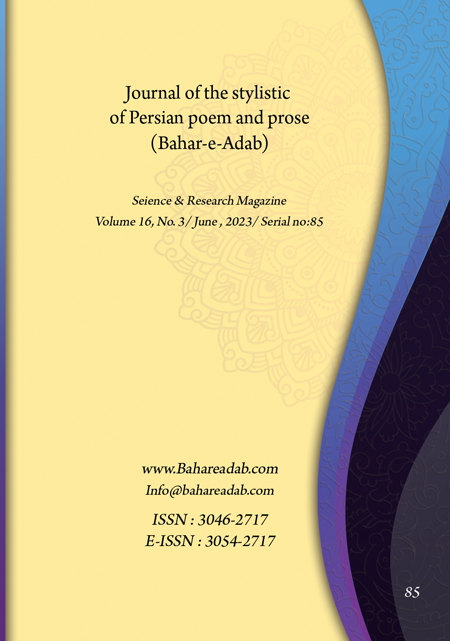- Count View : 342
- آدرس کوتاه شده مقاله: https://bahareadab.com/article_id/1457
- کد doi مقاله: Doi: 10.22034/bahareadab.2023 .16 .6866
Journal of the stylistic of Persian poem and prose
volume Number 16،
number In Volume 3،
،
issue Number 85
The role of messengers (fereste) in Shahnameh
Masoud Shafiei , Sima Mansoori (Author in Charge), Masoud Pakdel , Mansooreh Tadayoni
Abstract
BACKGROUND AND OBJECTIVES: The present essay examines the mythological and epic characters of Ferishte in Ferdowsi"s Shahnameh and uses Pahlavi books as a supplement and evidence. The purpose of this research was to take a closer look at the mythological and epic nature of Fereste and examine the conceptual distinction between the use of Fereste in the Shahnameh and in the sources of the Shahnameh. In order to deeply understand these distinctions, it is inevitable to divide the types of use of the messenger and the Minoan messengers that are interpreted as "angels" in common usage, along with the attributes and characteristics of the messengers and the motives of sending the messenger in the national epic, have been examined.
METHODOLOGY: This research was done in a library method and descriptive-analytical method based on comparison, interpretation and explanation.
FINDINGS: The studies and investigations of this research have shown that some attributes and characteristics of the messengers and the double importance of the messenger in the epic are taken from Shahnameh sources such as Pahlavi and Avesta works.
CONCLUSION: In this article, the term "angel" refers to the supernatural beings who have been assigned and sent by Ahura Mazda to carry out both their helping and messaging actions. The characters of these messengers are a model for messengers, couriers and war ambassadors in verse epics such as Ferdowsi"s Shahnameh.
Keyword
messenger(angel)
, Shahnameh
, motifs
, wisdom
- Ancient Avesta. (2003). by the efforts of Reza Moradi Ghiyathabadi, Shiraz: Navid Shiraz.
- Avesta. (2010). according to the report of Jalil Dostkhah, Tehran: Morvarid.
- Beyhaqi, Abulfazl. (2008). History of Beyhaqi, by Khalil Khatib Rahbar. Edition 14. Tehran: Mahtab.
- Christian Sen, Arthur. (2007). The first man and the first prince. Translated by Jale Amouzgar and Ahmad Tafzoli. Tehran: Cheshme.
- Dadegi, Farnbagh. (2006). Bondaheshn. According to Mehrdad Bahar. Third edition. Tehran: Toos.
- Ferdowsi, Abulqasem. (1996). Shahnameh. By the efforts of Saeed Hamidian. Tehran: Qatre.
- Homer. (2010). Iliad. Translated by Saeed Nafisi. second edition. Tehran: Sepehr Adab.
- Khosrow Kikavos. (2007). Faramarzname. Tehran: World of Books.
- Minoy Kherad. (2006). by the efforts of Jale Amoozgar. Translated by Ahmad Tafzoli. fourth edition. Tehran: Toos.
- Razi, Hashem. (2000). Hikmat Khosravani. Tehran: Behjat.
- Razi, Hashem. (2011). Encyclopedia of Ancient Iran. Tehran: Sokhan.
- Razi, Hashem. (2011). The Mysterious History of the Mithraic Religion. Tehran: Behjat.
- Rezaee Dasht Arjaneh, Mahmoud. (2014). The glory of wisdom in Ferdowsi's Shahnameh. Tehran: Scientific and Cultural.
- Sarami, Gadhamali. (2012). From the color of the flower to the pain of the thorn. Sixth edition. Tehran: Scientific and Cultural.
- Si roze koochak va si roze bozorg. (1984). by the effort of Dehdashti Azarmeidoht. Tehran: Farvahar.
- Tarane Rolan. (2004). translated by Faridah Mahdavi Damghani. Tehran: Tir.
- Vahedoost, Mahvash. (2000). Mythological Institutions in Ferdowsi's Shahnameh. Tehran: Soroush.

